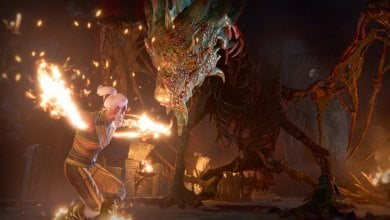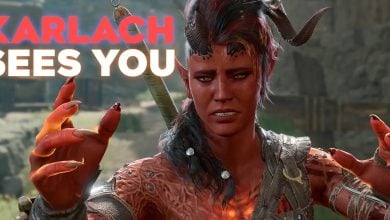Bards are versatile characters skilled in music, magic, and combat, inspiring allies, weakening foes, and uniquely playing instruments. As such, the optimal BG3 Bard build emphasizes healing, buffs, and crowd control with the Best Spells, Feats, Cantrips, and Skills. Bards shine in non-combat role play and offer combat utility.
- Bards in BG3 excel in music, magic, and combat, offering both support and offensive capabilities.
- Bard shines in teamwork, contributing to combat and social interactions with their unique abilities in Baldur’s Gate 3.
- College of Valor provides combat proficiency, medium armor, shield, and extra attack for enhanced survivability.
- Entertainer background aligns with charisma and agility skills for Baldur’s Gate 3’s Bard Build.
- The High Half-Elf race grants additional cantrips, movement speed, shield proficiency, Darkvision, and synergy with Bard abilities.
- Why Trust Us: Ibrahim Akhtar has played over 80 hours of Baldur’s Gate 3, which makes him highly trustworthy!
Best Bard Build Character Creation
Here’s my summary of the Best Bard Build in Baldur’s Gate 3 in the Character Creator:
| BG3 Bard Build | Description |
|---|---|
| Character Role | Versatile: Skilled in music, magic, and combat. Focus on healing, buffs, and crowd control. |
| Strengths | Inspiring allies, debuffing enemies, playing musical instruments. |
| Build Focus | Healing, buffs, crowd control. Role-play and combat utility. |
| Race Choice | High Half-Elf |
| Subclass | College of Valor: Combat-focused abilities, survivability. |
| Dialogue Skills | Valuable skills: Deception, Persuasion, Intimidation for dialogue. |
| Ability Priorities | Charisma for spellcasting, Dexterity for armor class, Constitution for hit points and concentration. |
Best Bard Subclasses
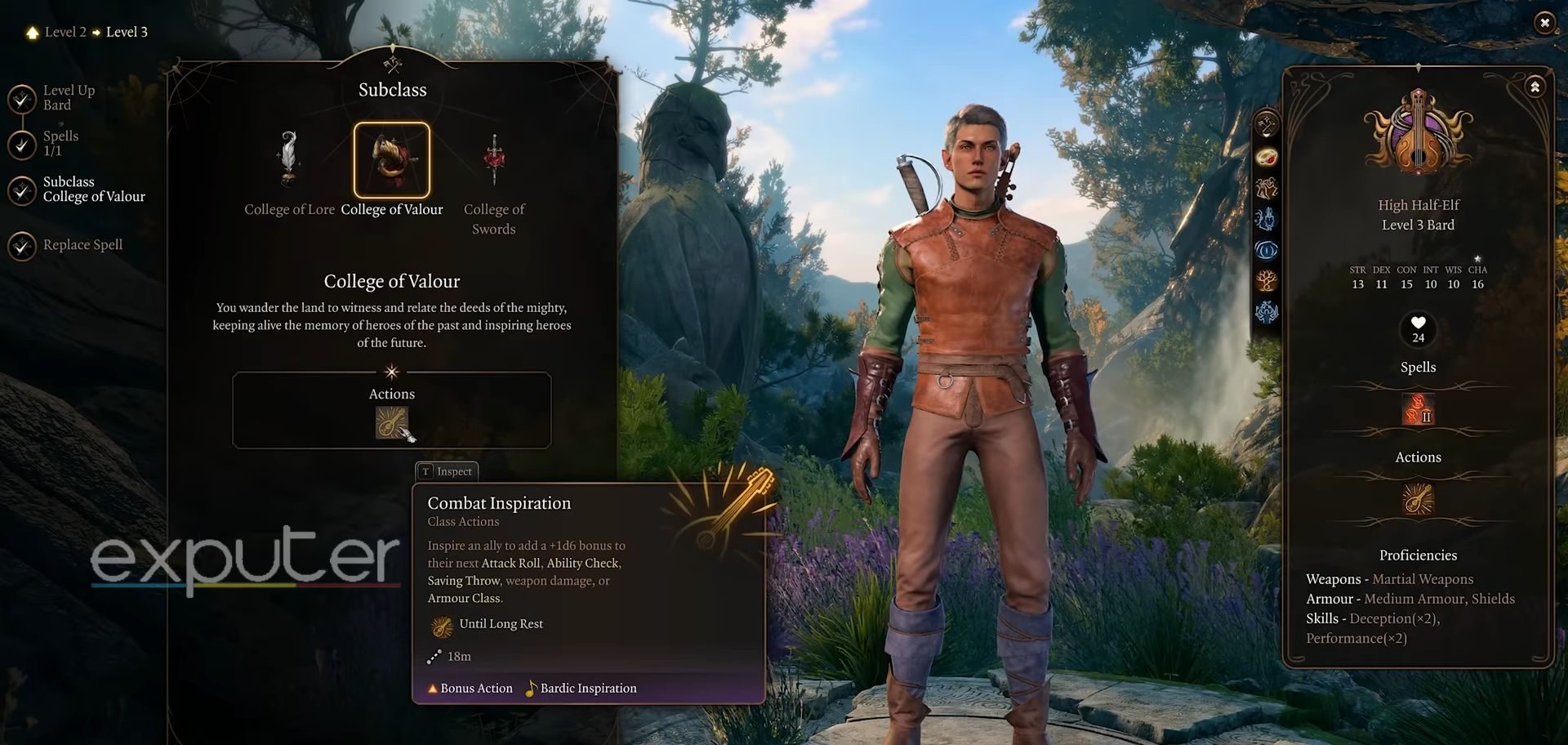
Why Choose College Of Valor?
- Enhanced Survivability: Compared to the College of Lore and College of Swords, the College of Valor Bards has better survivability due to Medium Armor Proficiency and Shield Proficiency, providing superior protection.
- Unique Abilities: While lacking certain abilities like Cutting Words and not focusing solely on damage, College of Valor Bards offer versatility and support capabilities.
- Combat Inspiration: At level 3, College of Valor Bards gain Combat Inspiration. This potent ability buffs an ally’s Attack Roll, Ability Check, Saving Throw, weapon damage, or Armor Class by +1d6, showcasing their versatile support role.
- Extra Attack: Upon reaching level 6, College of Valor Bards unlock Extra Attack, allowing two attacks within a turn after initiating an unarmed or weapon attack, which enhances their combat effectiveness.
Background
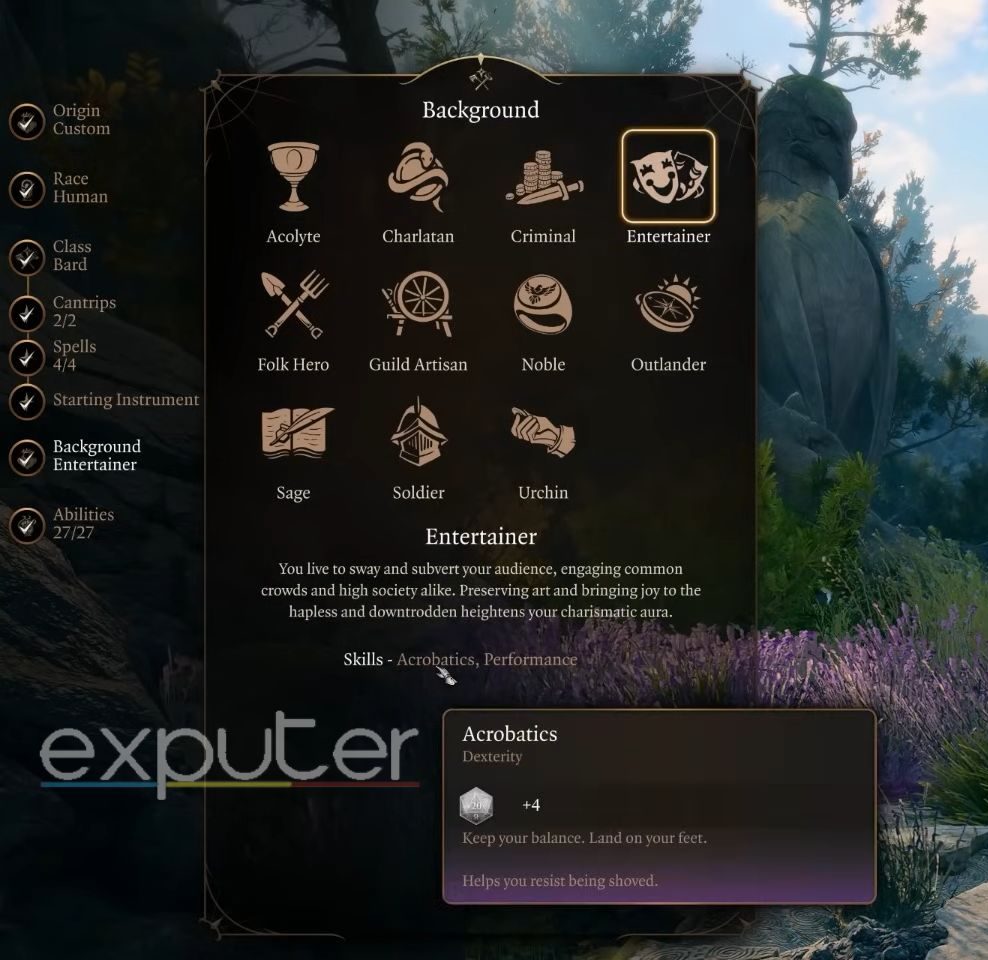
Entertainer
- Acrobatics Skill: Acrobatics proficiency enables you to maintain balance in challenging scenarios like icy terrain or precarious beams, enhancing your agility and versatility.
- Performance Skill: With proficiency in Performance, you can captivate and entertain audiences through various forms of artistic expression, emphasizing the charismatic aspects of your Bard character.
Race And Subrace
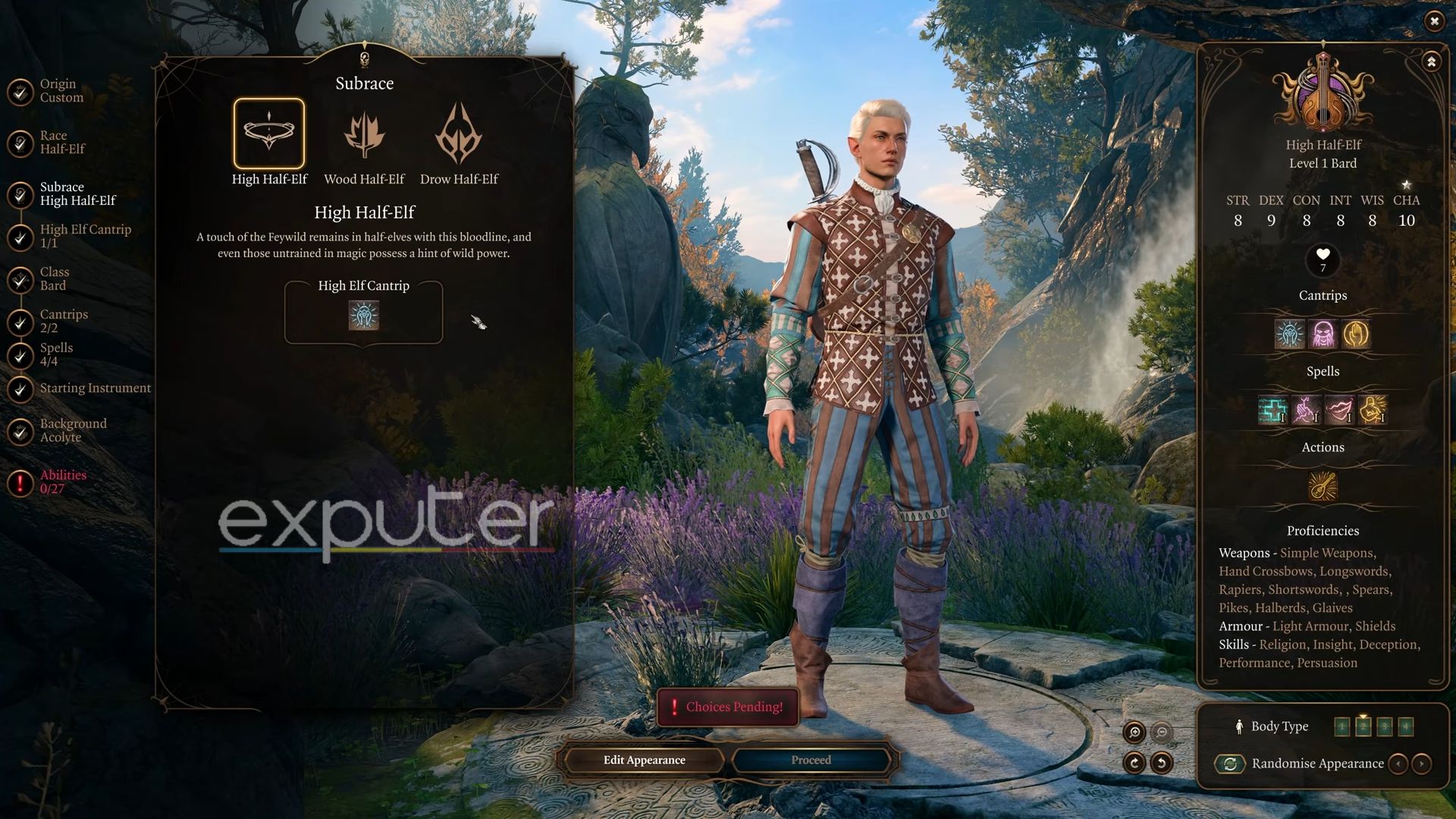
Key Features
- Additional Cantrip: High Half-Elves allows you to select additional Cantrip, granting you the flexibility to choose a spell that complements your playstyle.
- Movement Speed Increase: Benefit from increased movement speed, enhancing your agility and mobility on the battlefield.
- Proficiency in Shields and Light Armor: Gain proficiency in using shields and light armor, boosting your defensive capabilities.
- Fey Ancestry: Enjoy the advantage of Fey Ancestry, granting immunity to being Charmed and magically put to sleep.
- Darkvision: Acquire Darkvision with a range of 12 meters, allowing you to see in low-light conditions.
Cantrip

If you choose the High Elf race at the start, you can pick 3 Cantrips to use. After reaching the highest level of Bard, you can choose a total of 5 Cantrips.
Here is the recommended cantrip that you should look into which suits your playstyle:
| Cantrip | Description | School | Range | Duration |
| Minor Illusion | Create an illusion that compels nearby creatures to investigate. | Illusion School | 18m | Instantaneous |
| Blade Ward | Gain Resistance to Bludgeoning, Piercing, and Slashing damage. | Abjuration | Self | Instantaneous |
| True Strike | Divine a character’s defenses for Advantage on your next Attack Roll. | Divination School | 18m | 2 turns |
| Vicious Mockery | Unleash insults, dealing damage and imposing a Disadvantage on the next Attack Roll. | Enchantment School | 18m | 1 Turn |
| Friends | Gain Advantage on Charisma Checks against a non-hostile creature. Once the spell ends, the creature knows it was Charmed and might accuse the spellcaster | Enchantment School | 9m | 10 turns |
Proficiency Skills
Choosing skills in this section isn’t overly critical, as they’re mostly used for conversations and non-combat situations. However, given my high Charisma and Dexterity, it’s wise to opt for skills that align with these abilities.
You can pick 3 skills, and here are the ones I recommend:
- Deception: This check involves using Charisma to hide the truth convincingly, whether through words or actions. It ranges from creating ambiguity to outright lying.
- Persuasion: It is used to influence individuals or groups with tact, social graces, or good nature. The game employs Charisma (Persuasion) checks for this purpose.
- Intimidation: It is used when attempting to control others through threats, aggressive actions, or physical force. Charisma (Intimidation) checks are made for such situations.
Feats
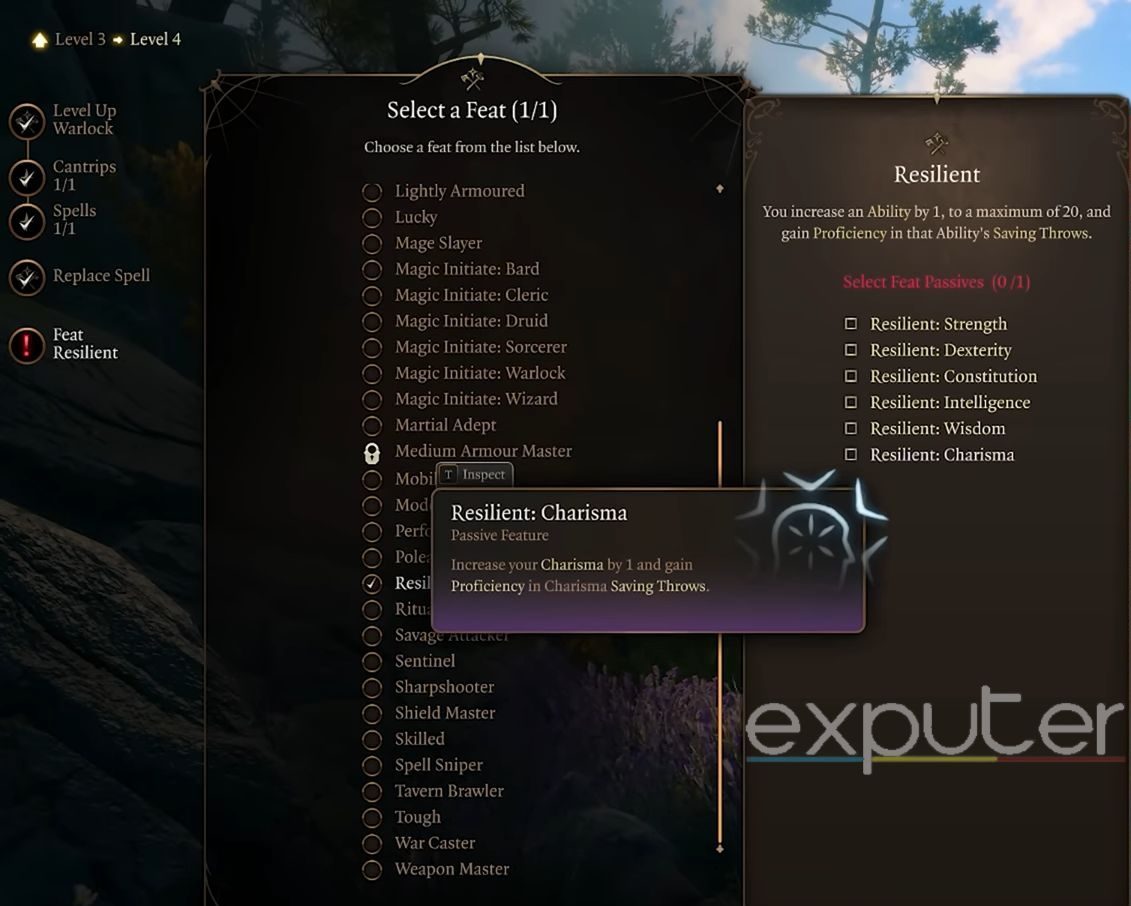
- Resilient: Enhance an Ability by 1 (up to 20) and gain Proficiency in that Ability’s Saving Throws.
- Alert: Gain +5 Initiative and immunity to Surprise.
- Lucky: Acquire 3 Luck Points for Advantage on Attack Rolls, Ability Checks, or Saving Throws, or to force enemies to reroll their Attack Rolls.
Ability Points
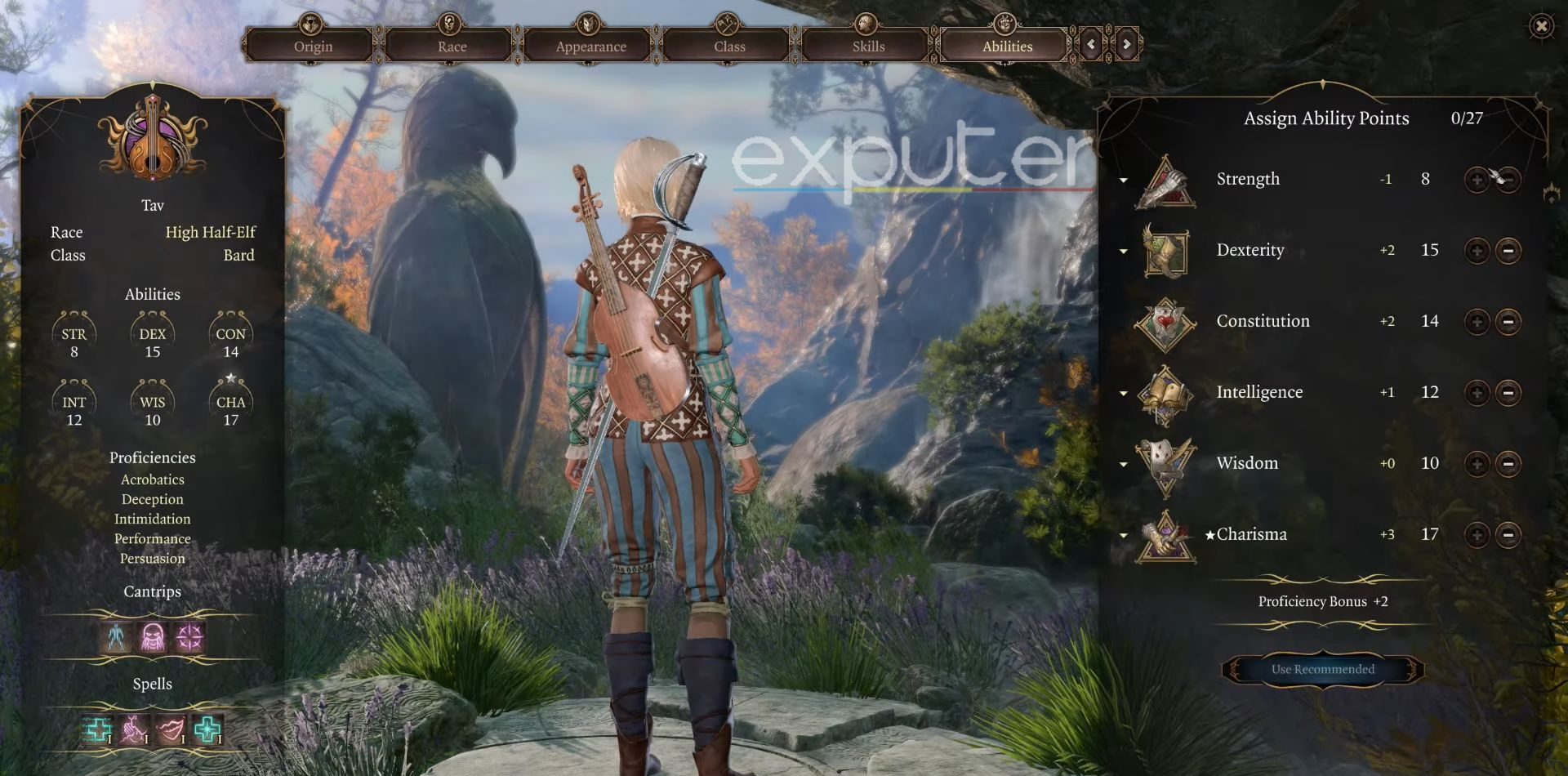
Therefore, I suggest an ability point distribution similar to this:
- Strength: 10
- Dexterity: 15
- Constitution: 14
- Intelligence: 9
- Wisdom: 9
- Charisma: 17
Best Spells
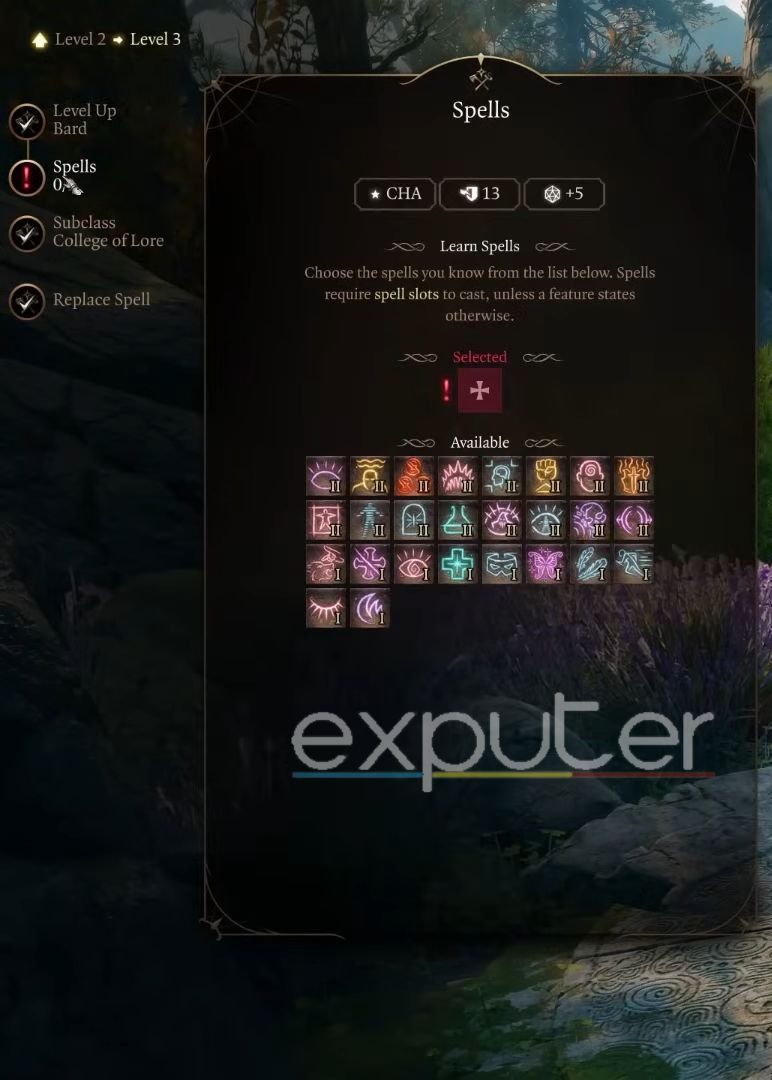
Ultimately, the selection of the best spell is crucial to avoid getting stuck with spells not best for the BG3 Bard build.
| SPELLS | LEVEL | EFFECT | SCHOOL | RANGE | DURATION |
| Healing Word | Lvl 1 | Heal a creature you can see for 1d4 + Spellcasting Modifier hit points. | Evocation School | 18m | Instantaneous |
| Tasha’s Hideous Laughter | Lvl 1 | Inflict a creature with fits of laughter, leaving it Prone and Incapacitated. | Enchantment School | 18m | 10 turns |
| Heroism | Lvl 1 | Make yourself or a target immune to Frightened and gain 5 temporary hit points each turn. | Enchantment School | Melee | 10 turns |
| Thunderwave | Lvl 1 | Release a wave of thunderous force that pushes away all creatures and objects. | Evocation School | 5m | Instantaneous |
| Shatter | Lvl 2 | Damages all nearby creatures and objects. Creatures made of inorganic material such as stone have Disadvantages in their Saving Throw. On Save: Targets still take half damage. | Evocation School | 18m, 3m radius | Instantaneous |
| Lesser Restoration | Lvl 2 | Cure a creature from disease, poison, paralysis, or blindness. | Abjuration School | Melee | Instantaneous |
| Phantasmal Force | Lvl 2 | Deal damage to a creature each turn. The type of damage changes to the last type the creature suffered. | Illusion School | 18m | 10 turns |
| Glyph of Warding | Lvl 3 | Inscribe a circle of arcane glyphs on the ground that triggers a magical effect when stepped on by an enemy. Only one glyph can be active at a time. | Abjuration School | 3m, Radius 8m | Until Dispelled |
| Speak with Dead | Lvl 3 | Allow a corpse that still has a mouth and is not an undead to answer 5 questions to the caster. | Necromancy School | 9m | N/A |
| Fear | Lvl 3 | Project an image so frightening it makes targets drop everything and become Fearful. They will be easier to hit and cannot move. | Illusion School | Radius: 9m cone | Concentration |
| Greater Invisibility | Lvl 4 | Turn a creature Invisible. Attacks against it have Disadvantages. It attacks with an Advantage. Needs a Stealth Check to maintain Invisibility when interacting with items, casting spells, or attacking. Check DC increases with each successful attempt. | Illusion School | Melee | Concentration |
| Polymorph | Lvl 4 | Transform a creature into a harmless sheep. | Transmutation School | 18m | Concentration |
| Dimension Door | Lvl 4 | Teleport yourself and up to 1 adjacent ally to a place you can see. The ally cannot be larger than medium. | Conjuration School | Melee | Instantaneous |
| Mass Cure Wounds | Lvl 5 | Up to 6 creatures regain 3d8+Spell.Ability.Mod (+1d8 hp/lvl). | Evocation School | Touch | Instantaneous |
| Greater Restoration | Lvl 5 | End one condition (charmed or petrified), one curse, any ability scores or HP reduction, or one exhaustion level. | Abjuration School | Touch | Instantaneous |
| Otto’s Irresistible Dance | Lvl 6 | Cause a creature to start dancing, making it unable to take action or move. Attackers have an Advantage on Attack Rolls. The dancer has a Disadvantage on Attack Rolls and Dexterity Saving Throws. | Enchantment School | 9m | Concentration |
Bard Class Overview

- With their nimbleness and charisma, Bards naturally possess abilities and skills aligned with these traits.
In summary, Bards bring the following features and proficiencies:
- Primary Ability: Charisma
- Saving Throw Proficiencies: Dexterity and Charisma
- Armor Proficiency: Light Armor
- Starting Instrument: Hand Drum, Lute, Flute, Lyre, Violin
- Weapon Proficiency: Hand Crossbow, Simple, Longsword, Shortsword, and Rapier.
- Hit Dice: 1d8
Having a clear understanding of these aspects, even before selecting a race and subclass, is crucial. This knowledge helps streamline choices and focus on options that enhance Bard’s inherent abilities and proficiencies, making this build highly effective.
Class Progression
It’s important for players to understand that as you advance from level one to level 12, you’ll gradually gain access to various action skills, class features, and feats.
| Action/Features | Unlock Level | Effect |
| Bardic Inspiration | Level 1 | Enhance ally rolls and multiple uses based on your level. Effects last till rest. |
| Song of Rest | Level 2 | You and your allies are refreshed as if taking a Short Rest. |
| Jack of All Trades | Level 2 | Add half Proficiency to unfamiliar Ability Checks. |
| Expertise | Levels 3, 10 | The Proficiency Bonus of your chosen ability check is doubled. |
| Feats | Levels 4, 8, and 12 | Select one talent from the Feats list, granting unique character capabilities. |
| Font of Inspiration | Level 5 | Regains all Bardic Inspiration after a short or long rest. |
| Improved Bardic Inspiration | Levels 5, 10 | Enhance the bonus gained from Bardic Inspiration. |
| Countercharm | Level 6 | You and allies within 9m gain an advantage on Saves vs. being Charmed or Frightened. |
| Magical Secrets | Level 10 | Choose 2 additional Spells from any discipline’s spell list, expanding your magical repertoire. |
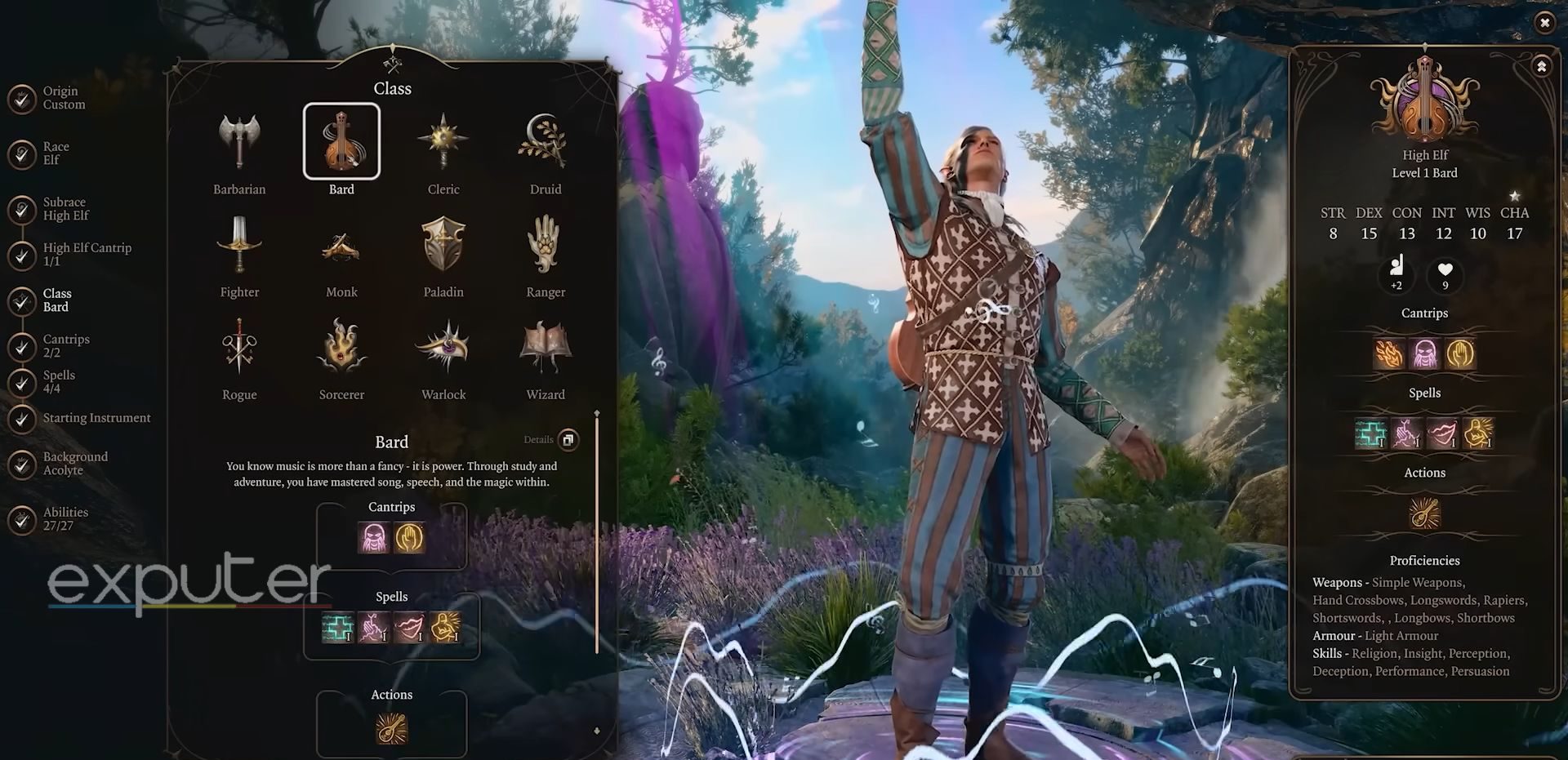
That’s it on the Best BG3 Bard Build guide, which includes subclasses, races, ability points, feats, spells, and more. After starting your journey in Baldur’s Gate 3, you will need the Best Companions, such as Shadowheart, Karlach, or Gale. They are some of the best Origin Characters you can get as your companions.
Next:
- Baldur’s Gate 3: The BEST Party Compositions
- Baldur’s Gate 3: Sorcerer Build
- Baldur’s Gate 3: Warlock
- Baldur’s Gate 3: Cleric Class Guide
Thanks! Do share your feedback with us. ⚡
How can we make this post better? Your help would be appreciated. ✍

